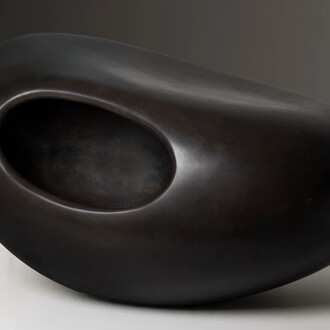Ippodo Gallery is pleased to present a selection of works by nine artists, in conjunction with the exhibition, A Teahouse for Philadelphia, at the Philadelphia Museum of Art (PMA). Ippodo artists, Jihei Murase, Tohru Matsuzaki, Suikei Saito, and Kenji Wakasugi, will be on view through July 30, 2018, so Ippodo welcomes the chance to run these artists in a concurrent showcase at our New York gallery, with additional works on view by five artists -- Keiji Ito, Akio Niisato, Shiro Tsujimura, Koji Hatakeyama, and Kyokko Kaida.
The exhibition centers around Wabi Sabi, a cultural tradition rooted in the beauty of imperfection and impermanence. Authenticity in this careful carelessness knows no translation, but is a celebration of all things natural and unadorned. It is a meditative aesthetic, and one greatly esteemed in Japanese culture. Each artist has an individual ability to express this Wabi Sabi ideal: Jihei Murase (b. 1957) creates harmonious lacquerware from 100-year-old timber and straight virgin trees, dried and prized for delicate, thin grooves to emphasize forms created by nature. Lacquerware by Tohru Matsuzaki (b. 1944) also uses precious zelkova wood, but the artist applies his hand to chiseling the grooves of the rich vermillion red, black and silver. Ceramics by Keiji Ito (b. 1935) are minimalistic, world renowned Shijo Tsujimura (b. 1947) ‘s rare pieces from his time in Devon (UK in 1993) are whimsical, and by younger Akio Niisato (b. 1977), having previously taught a Harvard ceramics from 2009-2012, all continue to evolve from a place of passion and creativity, and have been shown all over the world.
Kyokko Kaida (b.1946)’s bamboo tea scoops are poetic, while the weathered surfaces of Koji Hatakeyama (b.1956) ’s bronze boxes convey the material’s individual history.
The juxtaposition of forms, past and present ideals, and a delicacy of craft continue through more innovative techniques. This can be seen in the works by calligrapher, Suikei Saito (b. 1945), who explores stillness, nothingness, and emptiness. As a photographer, Kenji Wakasugi (b. 1941) digitally manipulates images on landscapes, striking a balance between tradition and modernity. Wakasugi uses Sumi ink, pigments, and gold and silver leaf on scanned photographs, with his most recent mixed media work an homage to the tea masters, Sen Rikyu and Oribe Huruta.
Ultimately this continues Ippodo’s efforts to sync with the natural world in an ongoing appreciation of the beauty of both artwork and the earth itself. This emphasis on technique and materials culled from the earth syncs with the ideals of Wabi Sabi, in that there is a play between tradition and modernity, while embracing the curvatures found organically. Through changing technologies and mixed media, each artist maintains these ideals of discovery and reverence, making for a worthy group show of proven museum-quality works.
















